Posts Tagged ‘Second World War’
-
THE SELLING GAME
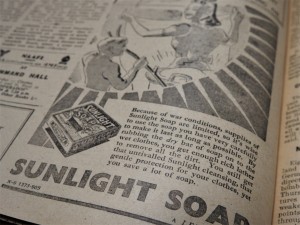 Advertising is said to reflect the societal tastes, beliefs and norms. By looking back at the adverts that were published in the Times of Malta at the end of the years 1939 to 1944, this becomes very clear. Yet even their absence during the days of war have much to say.
Advertising is said to reflect the societal tastes, beliefs and norms. By looking back at the adverts that were published in the Times of Malta at the end of the years 1939 to 1944, this becomes very clear. Yet even their absence during the days of war have much to say.There are whole studies and much research behind advertising. Adverts are used as a form of communication intended to convince an audience to purchase or take some action upon products, ideals or services. Their regularity aim to impact on memory to create a sense of familiarity and trust to buy those products.
Indeed, while turning the pages of November – December 1939 and 1940 of the Times of Malta, it is evident that a group of particular brands are always featuring. Most relate to health, beauty, alcohol, insurance, entertainment (mainly cinema), fashion and gifts.
Health adverts at the time generally focus on irritability of the stomach, laxatives, cold and fever, rheumatism, eczema, fatigue and sleeplessness. The message on the adverts is mainly delivered through drawings and long descriptions about the benefits of using the products.
 The text is generally presented in the form of a conversation – “Why continue to be agonised by Terrible Headaches, Niggling Nerve Pains, Black Depression, and Heavy-Limbed Lassitude?” – reads the introduction of an advert for tonic tablets.
The text is generally presented in the form of a conversation – “Why continue to be agonised by Terrible Headaches, Niggling Nerve Pains, Black Depression, and Heavy-Limbed Lassitude?” – reads the introduction of an advert for tonic tablets.“Do you realise the danger? Impure blood causes disease.” – says another advert selling a ‘blood mixture’ as ailment against rheumatism, lumbago, eczema, boils and pimples.
Communication with the readers is stark and direct – The word “Poisoned!” in capital black letters runs over the mouth of a man in the advert of a toothpaste. “Pyorrhoea has robbed him of his teeth, poisoned his whole system. Don’t let this happen to you.”
“Is running a house too much for you?” reads the title of an energy drink. “Do you feel that the cares of the household get you down and managing your servants is a strain?”
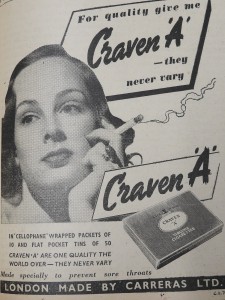 The quantity of adverts focusing on health issues form quite a big chunk of the advertising at the time. However, ironically, these are accompanied by cigarette adverts, one of which shows a beautiful young woman with a cigarette in her hand. A section of the advert text reads – “Made specially to prevent sore throats.”
The quantity of adverts focusing on health issues form quite a big chunk of the advertising at the time. However, ironically, these are accompanied by cigarette adverts, one of which shows a beautiful young woman with a cigarette in her hand. A section of the advert text reads – “Made specially to prevent sore throats.”Some of the adverts published at the time will certainly be unacceptable nowadays. Social class differences, sexism and offensive messages are quite typical.
“Women who belong to the 1st sleep group never grow old before their time. There are 3 groups. Which do you belong to?” – asks an advert selling Horlicks. “Most attractive women belong to the 1st sleep group.” – states another one. “Men who are sure of themselves belong to the 1st sleep group.” – and – “Men who get on in life nearly all belong to the 1st sleep group”.
 “Don’t look old! Tint those grey hairs with Shadeine.” – jumps at you an advert selling hair colour.
“Don’t look old! Tint those grey hairs with Shadeine.” – jumps at you an advert selling hair colour.Advertisements can influence strongly how we perceive things around us. By showing a high social class user of a product, the advert creates a longing or a pressure to purchase that item in order to belong to that level of society.
A skin-vitamin cream portrays the drawing of a beautiful lady, all dressed up in perfect make-up, set-up hair, a pair of lovely earrings and a crown. – “Lady Grenfell is one of the most beautiful among the young marrieds in Society…. She tells us, ‘I’m using Pond’s Creams containing the ‘skin-vitamin’, and they’re really amazing.”
“Many army and royal navy officers enjoy the comfort of our hand-made footwear. Why Not you? Sir.” – entices an advert showing the drawing of a highly elegant man sitting in a luxurious armchair while a shoe-maker sits on a stool to help him try on a new pair of shiny “Best English leather”.
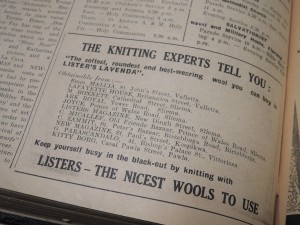 A shade of the effects of the Second World War, even though not yet happening in Malta is already present in adverts of 1939.
A shade of the effects of the Second World War, even though not yet happening in Malta is already present in adverts of 1939.“Keep yourself busy in the black-out by knitting with Listers – the nicest wool to use.” – advices an advert. “Bernards suggest that you give sensible gifts this Christmas. Such gifts as shirts, pyjamas, handkerchiefs, ties, socks, gloves and wool-slipovers all make very acceptable presents.” – recommends another one.
Not only adverts diminish in 1941 during the war days in Malta. Even the newspaper itself shrivels to a few pages although being published daily.
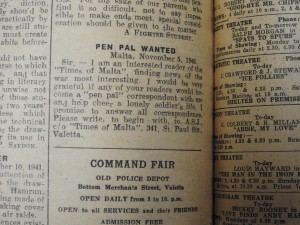 “Test your gas mask. Gas Chamber at Castile Place today.” – reads a warning advert on the front page of the Times of Malta on Tuesday, November 4, 1941. “There is no better way of ensuring that the respirator is still properly functioning than by putting it on and entering the gas chamber.”
“Test your gas mask. Gas Chamber at Castile Place today.” – reads a warning advert on the front page of the Times of Malta on Tuesday, November 4, 1941. “There is no better way of ensuring that the respirator is still properly functioning than by putting it on and entering the gas chamber.”Amid the difficulties of war, an advert speaks out the request for a pen pal – “I am an interested reader of the “Times of Malta”, finding news of the war most interesting. I would be very grateful if any of your readers would become a “pen pal” correspondent with me and help cheer a lonely soldier’s life.”
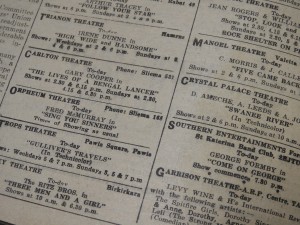 A considerable decrease of adverts continues in 1942. Alcohol adverts drop out completely. Cinema continues regularly in the following theatres – Manoel and Coliseum in Valletta, Gaiety, Majestic, Carlton and Orpheum in Sliema, Odeon, Thrianon and Rex in Ħamrun, Prince in Birkirkara, Buckingham and Royal in Żabbar, and Empire in Paola.
A considerable decrease of adverts continues in 1942. Alcohol adverts drop out completely. Cinema continues regularly in the following theatres – Manoel and Coliseum in Valletta, Gaiety, Majestic, Carlton and Orpheum in Sliema, Odeon, Thrianon and Rex in Ħamrun, Prince in Birkirkara, Buckingham and Royal in Żabbar, and Empire in Paola.“What do I do…. about the black market?” runs an advert issued by the Information Office. A Wartime Reminder advert issued by the same Office reminds people that “Imported Fuel is used for pumping Water. Reduced consumption of water saves Fuel. A saving in Fuel saves Freight, (and) Saving in freight helps to win the War.”
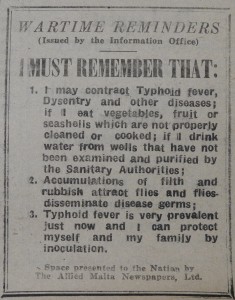 Another Wartime Reminder recommends the adequate washing of vegetables, fruit and seashells, and their proper cooking while warning against the accumulation of filth, since these may lead to Typhoid fever and Dysentry. Inoculation against the Typhoid fever is also advocated.
Another Wartime Reminder recommends the adequate washing of vegetables, fruit and seashells, and their proper cooking while warning against the accumulation of filth, since these may lead to Typhoid fever and Dysentry. Inoculation against the Typhoid fever is also advocated.The siege on the Maltese Islands effectively ended in November 1942. Yet adverts show that life took time to return to normal especially since the Second World War had not yet ended in other countries.
An advert issued by the N.F.U advices to eat cabbage and cauliflower to keep fit. Another advert informs its clientele that “Because of war conditions, supplies of Sunlight Soap are limited, so it’s wise to use the soap you have very carefully to make it last as long as possible.”
Even tennis balls were restored instead of purchasing new ones – “Hand in your old Tennis Balls to any of the Sports Dealers named below, who will forward them to Slazengers for renovation by a special process which includes reinflation and provision of a new outside cover.”
During the days of war, a few selected companies such as Bovril, managed to stay in the public eye through advertisements. “Makes all the difference between bread and butter.” The Bovril advert states. “A 4-oz. Bottle of Bovril makes over 100 delicious sandwiches.”
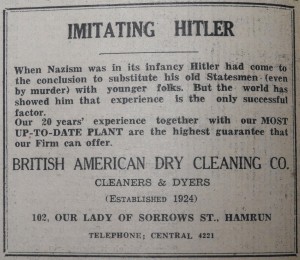 Other adverts such as the one for Dettol portrayed the company’s involvement in the war efforts and reminded that the product should be used with “measured care” in order to keep the supply flowing.
Other adverts such as the one for Dettol portrayed the company’s involvement in the war efforts and reminded that the product should be used with “measured care” in order to keep the supply flowing.Marketers have always adapted to changing business demands when it comes to creating new advertisements. However, there are moments when their creativity is quite shocking – “Imitating Hitler” screams the title in bold capital letters of the British American Dry Cleaning Co.
(This feature was published in the Christmas Supplement issued with the Times of Malta dated 1st December 2019)
-
NEVER FORGOTTEN
 Recently, Max Farrugia has donated a collection of 10,500 memorial cards to the National Archives of Malta. I was curious to learn why someone would wish to have such a collection and what was its value to the national archives.
Recently, Max Farrugia has donated a collection of 10,500 memorial cards to the National Archives of Malta. I was curious to learn why someone would wish to have such a collection and what was its value to the national archives.“Initially, I started this collection in order to pray for the souls of the dead,” revealed Max. “I would separate the memorial cards into sets according to the village or town they came from. Then, each week, my family and I would choose a set, spread the memorial cards on a table and pray for their souls.”
“We were aware that among those individuals, there were elders who had no one to pray for them and so we did. We also believe that prayers can be passed on to other souls if the person we are praying for is already in heaven. Flowers wither, tears dry out but a prayer is always beneficial.”
Max succeeded to gather such a huge collection, mostly by word of mouth, and also a touch of luck, here and there.
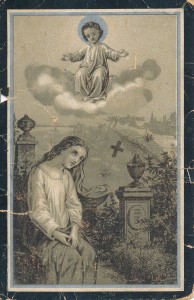 “I am 73 now and I have been collecting memorial cards for many years. When people learn that you have such an interest, they would generally help you out. I still receive packs of memorial cards in my letter box. Facebook is another great tool for such things. Whenever I post a request for memorial cards, someone will always respond,” he said as he smiled.
“I am 73 now and I have been collecting memorial cards for many years. When people learn that you have such an interest, they would generally help you out. I still receive packs of memorial cards in my letter box. Facebook is another great tool for such things. Whenever I post a request for memorial cards, someone will always respond,” he said as he smiled.Then there are moments of serendipity.
“One day, I was attending mass at the chapel of Fort St Angelo and I noticed a memorial card in the sacristan’s hand. I approached him and asked him whether I could have it since I was a collector. He gave it to me eagerly and told me to return within an hour so that he could bring me more. There were 400 memorial cards waiting for me when I returned!”
Some of the memorial cards in this collection go back more than 100 years. One of the oldest ones was discovered accidentally.
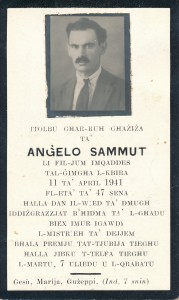 “I was at the DOI office to get some documents and while I waited, I started to talk with one of the officials. Soon I learnt that he lived in Birżebbuġa and when he continued to elaborate, I realised that he had purchased my great grandfather’s house. When I told him that, he informed me that he had found two old memorial cards in a piece of old furniture in that house. We met later on and he gave them to me. The memorial cards were of my great grandfather dating to 1897 and his brother.”
“I was at the DOI office to get some documents and while I waited, I started to talk with one of the officials. Soon I learnt that he lived in Birżebbuġa and when he continued to elaborate, I realised that he had purchased my great grandfather’s house. When I told him that, he informed me that he had found two old memorial cards in a piece of old furniture in that house. We met later on and he gave them to me. The memorial cards were of my great grandfather dating to 1897 and his brother.”As he opened some of the boxes brimming with memorial cards, Max selected a number of them to explain their research value to me.
“These memorial cards are rich with information for researchers. For example, they can be very significant to genealogists when they are tracing people to build a family tree. From the date of the demise of a person, one can research for further information at the Public Registry, where one would then obtain the date of birth. From the birth certificate, one can then identify the parents, and can continue to trace back the grandparents and so on.”
 The images of the saints on memorial cards, which are generally patron saints, will reveal the location which the deceased came from.
The images of the saints on memorial cards, which are generally patron saints, will reveal the location which the deceased came from.“From this information, a researcher can then look for more details in the particular parish archives. Look at this memorial card,” he said as he chose one of them. “On the left side, there is an image of Christ the King which is the patron saint of Paola and on the right, there is the image of the Immaculate Conception which is Cospicua’s patron. This means that this person was born in Paola and then he moved to Cospicua.”
The National Archives hold a vast collection of passports and from them, researchers manage to find photos of people and other details. Yet, this collection does not cover those persons who were never abroad. This lacuna can be filled through the collection of memorial cards. Interestingly, from this collection, one can also trace Maltese people who emigrated and died in Australia and in other countries, since their Maltese relatives tend to organise a mass in Malta to pray for their souls and give out memorial cards to those who attend.
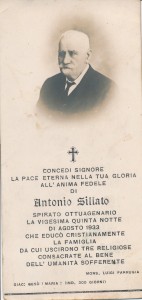 “As you can see, memorial cards can serve to tell a social and a cultural narrative. They also have a historical and an anthropological value. For example, when one compares memorial cards of different periods, one can notice the development of printing. One can also observe the use of different languages in various villages and towns, with some using the English language while others prefering Italian. As time passes, one can then follow the introduction of Maltese and the evolution of the language’s spelling as years go by.”
“As you can see, memorial cards can serve to tell a social and a cultural narrative. They also have a historical and an anthropological value. For example, when one compares memorial cards of different periods, one can notice the development of printing. One can also observe the use of different languages in various villages and towns, with some using the English language while others prefering Italian. As time passes, one can then follow the introduction of Maltese and the evolution of the language’s spelling as years go by.”“Originally, memorial cards were meant to be placed in a Missal in order to pray for the souls during mass. However, modern memorial cards tend to be bigger in size, making this practice difficult.”
Max Farrugia is one of the founders of the NGO ‘Friends of the National Archives’. The main objective of this NGO is to raise public awareness of the work of the National Archives, and the importance of preserving documents of historical value. It also offers assistance and support to the National Archives by various means, including fundraising and the promotion of a volunteers’ scheme.
“This collection of memorial cards will now form part of the project MEMORJA,” explained James Baldacchino, the administrator of the MEMORJA Project at the National Archives of Malta.
 MEMORJA is an oral, sound and visual archive. Its main objective is to employ cutting edge research, methodologies, theoretical and archival approaches and techniques to collect, record, transcribe, preserve and make available and retrievable all the deposited material detailing the islands’ history.
MEMORJA is an oral, sound and visual archive. Its main objective is to employ cutting edge research, methodologies, theoretical and archival approaches and techniques to collect, record, transcribe, preserve and make available and retrievable all the deposited material detailing the islands’ history.“Initially, we started out with four themes, namely the Second World War, the British expatriates in Malta, public administration, and the Lampedusa-Malta connection. Then, we added two others – the Malta buses and transport and the bell-ringers. However, our country is blessed with so much history that you continue to expand as people approach you with different valuable memories. In this case, Max Farrugia has introduced the death theme with all its significant meanings.”
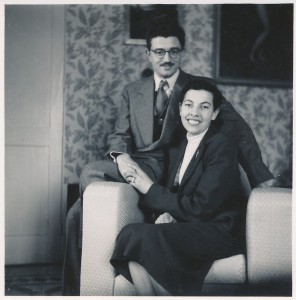 “Through this project, we found a huge amount of data which existed only in the minds of people and in their photos. Many individuals were enthusiastic to make their voice heard in order to help out with the shaping of the public’s narrative which up to now was not formally recorded for posterity. They were also very generous in donating or allowing us to copy hundreds of personal family photos from which we can identify various themes such as social life, fashion, local landscape, celebrations, food and much more.”
“Through this project, we found a huge amount of data which existed only in the minds of people and in their photos. Many individuals were enthusiastic to make their voice heard in order to help out with the shaping of the public’s narrative which up to now was not formally recorded for posterity. They were also very generous in donating or allowing us to copy hundreds of personal family photos from which we can identify various themes such as social life, fashion, local landscape, celebrations, food and much more.”Gathering records for MEMORJA is all about reciprocal patience and trust. James spends several hours over a period of time, visiting people who are interested to be interviewed until they are ready to give out the formal experience on record. He showed me several photos which were handed to him. All this information will soon be available on a website which the National Archives is currently working on.
Max Farrugia can be contacted on maxfarrugia46@gmail.com
If you are interested to contribute to the MEMORJA Project, you are invited to contact James Baldacchino on james.baldacchino@gov.mt or call 21459863.
The National Archives is located at ‘Santo Spirito’, Hospital Street, Rabat, Malta.
(Note – This article was published in SENIOR TIMES – November 2019 issued with The Times of Malta on Friday 15th November 2019)
-
FROM STORIES TO HISTORY
For hundreds of years, the recording of the past focused on public records, statistical data and the lives of prominent people. Yet in recent decades, the spotlight turned onto the general public and its memories in order to provide a more accurate picture of the historic narrative.
 “People who have lived through particular events can contribute different viewpoints and perspectives that fill in the gaps of documented history, at times correcting or even contradicting the written record. The project MEMORJA aims to give a voice to those who have been unheard,” explained James Baldacchino, the administrator of the MEMORJA Project.
“People who have lived through particular events can contribute different viewpoints and perspectives that fill in the gaps of documented history, at times correcting or even contradicting the written record. The project MEMORJA aims to give a voice to those who have been unheard,” explained James Baldacchino, the administrator of the MEMORJA Project.MEMORJA is an oral, sound and visual archive. Its main objective is to employ cutting edge research, methodologies, theoretical and archival approaches and techniques to collect, record, transcribe, preserve and make available and retrievable all the deposited material detailing the islands’ history.
“Work on this project has begun in January 2017. This is a new platform which is giving an additional dimension to the National Archives since this time, it is not only collecting records but reaching out to create them.”
At the early stages of the project, four themes were selected, namely the Second World War, British expatriates in Malta, public administration and the Lampedusa-Malta connection.
 “The theme related to experiences during the Second World War aims to document and record a past which is slowly disappearing from public memory especially with the passing away of the older generation. Oral testimonies and photographs serve to recollect the terrible years of war and what the people have lived through in those times. Stories of the outbreak of hostilities and the first bombings on June 11, 1940, the mass evacuations and refugee experiences, fear and uncertainty, hunger and the Victory Kitchens, shelters and sanitation, soldiers and sirens, and tragedies of bombings are part of the significant remembrance which needs to be collected and preserved for future generations before it is lost for good.”
“The theme related to experiences during the Second World War aims to document and record a past which is slowly disappearing from public memory especially with the passing away of the older generation. Oral testimonies and photographs serve to recollect the terrible years of war and what the people have lived through in those times. Stories of the outbreak of hostilities and the first bombings on June 11, 1940, the mass evacuations and refugee experiences, fear and uncertainty, hunger and the Victory Kitchens, shelters and sanitation, soldiers and sirens, and tragedies of bombings are part of the significant remembrance which needs to be collected and preserved for future generations before it is lost for good.”The history of the relationship between the UK and Malta is another central theme which has not been documented through the eyes of the British and Maltese individuals.
 “This section includes interviews with British and British-Maltese people who were either in the British forces during the 1960’s (or their spouses) and remained in Malta, or civilians who married a Maltese person and relocated to Malta. Such recordings open a window on everyday life in Malta during the 1950s – 1970s. Much of the narratives relate to military bases, post-war experiences, political issues, relationships and cultural differences. This theme was further expanded when the experience of service families’ children was included as well. These children had attended the Naval Childrens’ School and HM Dockyard Children’s School which had occupied sites at Ta’ Xbiex, Cottonera, Senglea and the Dockyard before moving to Tal-Ħandaq.”
“This section includes interviews with British and British-Maltese people who were either in the British forces during the 1960’s (or their spouses) and remained in Malta, or civilians who married a Maltese person and relocated to Malta. Such recordings open a window on everyday life in Malta during the 1950s – 1970s. Much of the narratives relate to military bases, post-war experiences, political issues, relationships and cultural differences. This theme was further expanded when the experience of service families’ children was included as well. These children had attended the Naval Childrens’ School and HM Dockyard Children’s School which had occupied sites at Ta’ Xbiex, Cottonera, Senglea and the Dockyard before moving to Tal-Ħandaq.” Civil servants are often regarded as those who are implementing the Goverment’s policies. However, through their memories we can get a glimpse of what happenned ‘behind the scenes’ during the most important political, social and economic decisions undertaken by Maltese political leaders.
Civil servants are often regarded as those who are implementing the Goverment’s policies. However, through their memories we can get a glimpse of what happenned ‘behind the scenes’ during the most important political, social and economic decisions undertaken by Maltese political leaders.“These include background revelations of what was taking place during the granting of Independence in 1964, the dismantling of the British military base in 1979 and how the Maltese prepared for such an event, membership in the EU and how it affected the civil service, the migration of the hospital from St Lukes to Mater Dei and many other memorable challenges.”
Lampedusa and Malta are two islands with different political histories. Yet to some extent they share similar economic, trade and socio-cultural interest.
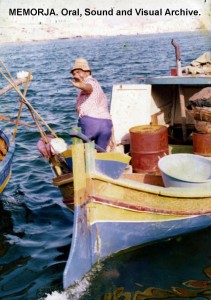 “We have an interest in Lampedusa since in the early 1800s, there were a number of Maltese settlers on this island. Until now, no one had attempted to record these people’s history in order to understand the link between the two islands. The MEMORJA Project is focusing on two time frames to investigate the islands’ shared history. The first one relates to the period from 1800 – 1843 when Lampedusa was colonised by Maltese settlers working in agriculture and animal husbandry. The second covers the period between the 1950s and the 1980s when Lampedusani fishermen visited Malta regularly for the maintenance of ships, the sale of blue fish and the provision of supplies.”
“We have an interest in Lampedusa since in the early 1800s, there were a number of Maltese settlers on this island. Until now, no one had attempted to record these people’s history in order to understand the link between the two islands. The MEMORJA Project is focusing on two time frames to investigate the islands’ shared history. The first one relates to the period from 1800 – 1843 when Lampedusa was colonised by Maltese settlers working in agriculture and animal husbandry. The second covers the period between the 1950s and the 1980s when Lampedusani fishermen visited Malta regularly for the maintenance of ships, the sale of blue fish and the provision of supplies.”As the team of the MEMORJA Project reached out to people, they were soon welcomed by the different communities who were eager to share their recollections.
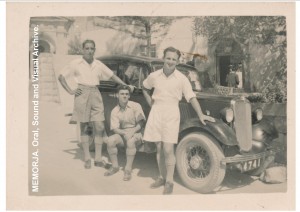 “We found a huge amount of data which existed only in the minds of people and in their photos. Many individuals were enthusiastic to make their voice heard in order to help out with the shaping of the public’s narrative which up to now was not formally recorded for posterity. Even though we have four selected themes, it does not exclude us from recording other memories as well which we deem to be of importance to form part of the community memory.”
“We found a huge amount of data which existed only in the minds of people and in their photos. Many individuals were enthusiastic to make their voice heard in order to help out with the shaping of the public’s narrative which up to now was not formally recorded for posterity. Even though we have four selected themes, it does not exclude us from recording other memories as well which we deem to be of importance to form part of the community memory.”The search for the stories which make the history is still going on. The final goal of the MEMORJA Project which will be officially launched later on this year will be to make this information accessible online for educational and research purposes.
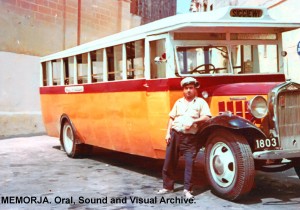 “Oral history allows people to express the personal consequences of change, from the simplest things in life to the more complex. It enables people to share their experiences in their own words, with their own voices, through their own understanding of what happened and why. Eventually, such documentation will offer depth to the understanding of the past to present and future generations.”
“Oral history allows people to express the personal consequences of change, from the simplest things in life to the more complex. It enables people to share their experiences in their own words, with their own voices, through their own understanding of what happened and why. Eventually, such documentation will offer depth to the understanding of the past to present and future generations.”If you are interested to contribute to the MEMORJA Project, you are invited to contact James Baldacchino on james.baldacchino@gov.mt or call 21459863.
The National Archives is located at ‘Santo Spirito’, Hospital Street, Rabat, Malta.
(This article was published in SENIOR TIMES – MAY 2018 issued with The Times of Malta dated 24 May 2018)
-
Take me to church
“ ‘They have hit our church!’ cried a man as he stumbled down in the tunnel which was located under the Mall Garden. We were huddling in there for shelter together with many other people as the bombs came down over Floriana,” reminisced Pawlu Piscopo who was eight at the time.
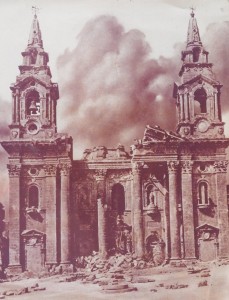 “At this horrible news, my father grabbed me and my brother by the hand and took us out of the tunnel and over to the granaries where a very sad spectacle awaited us. St Publius’ Church had suffered a direct hit. Its dome was gone and the area was surrounded in rubble. Thirteen people who were taking cover in the church’s crypt were killed and eleven more were injured. That was the blackest moment in the history of the parish church of Floriana: April 28, 1942 at 7:50am.”
“At this horrible news, my father grabbed me and my brother by the hand and took us out of the tunnel and over to the granaries where a very sad spectacle awaited us. St Publius’ Church had suffered a direct hit. Its dome was gone and the area was surrounded in rubble. Thirteen people who were taking cover in the church’s crypt were killed and eleven more were injured. That was the blackest moment in the history of the parish church of Floriana: April 28, 1942 at 7:50am.”After their house had been bombed, Pawlu’s family were allowed to take some respite in a large residence which today houses the Floriana Local Council. Yet for four years, they lived mostly underground in this tunnel which probably saved their lives. They took with them only a few belongings and the most cherished items, including a statue of St Publius which dated back to 1928 and used to adorn the model altar that his father had constructed at home.
“Most families in Malta had a model of an altar or a miniature church at home at the time. Unfortunately, many of these had to be abandoned during the war and a good number of them were destroyed when the houses were bombed.”
The craft of church model-making had been introduced to our islands by the Knights of St John back in the 16th century, and therefore its knowledge was a distinct tradition. However the adversity of war ravaged even this precious memory until eventually this craft was almost completely forgotten.
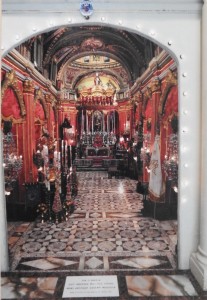 “After the war, people tried to get on with their lives as best as they could. Shops started to open again but those that used to sell miniature items with which to decorate our religious models, dwindled down to almost none. Nevertheless, the passion for model-making was much engrained in our family and when I bought a miniature structure made of four columns and a dome from a man who was leaving Malta to go to live in Australia, my father Carmelo was inspired to use it as the foundation for a model of St Publius’ church,” explained Pawlu.
“After the war, people tried to get on with their lives as best as they could. Shops started to open again but those that used to sell miniature items with which to decorate our religious models, dwindled down to almost none. Nevertheless, the passion for model-making was much engrained in our family and when I bought a miniature structure made of four columns and a dome from a man who was leaving Malta to go to live in Australia, my father Carmelo was inspired to use it as the foundation for a model of St Publius’ church,” explained Pawlu.Carmelo was a very skilled carpenter. He would go from time to time to have a look at the church and then go back to his model and construct an exact copy of the section that he had seen.
“He used the material which was handy at the time, mostly cardboard, wood and gypsum. I helped him out too in order to build the whole church which included ten altars. Eventually, this model reached a huge size of three by four metres and we could walk in it and look above at the beautiful dome,” Pawlu said proudly.
Once his father grew old, Pawlu continued with the work on this church which they had started back in the early 1960s. As he embellished this model, the wish to set up a group for model-makers in order to share this passion with them, burnt within him.
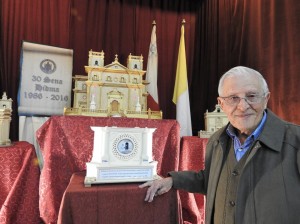 “On February 26, 1986 which happenned to be the tenth anniversary of my father’s demise, I discussed this idea with two of my friends, Raphael Micallef and Tony Terribile, who were very interested in this sector. We all agreed to do something in order to revive this craft and we sent out adverts in the newspapers to announce the set up of this group which we called Għaqda Dilettanti Mudelli ta’ Knejjes (Church Modelling Society). We were very happy when we received a great response from enthusiastic individuals all over Malta. Soon, a commitee was formed and on March 1986, we organized the first exhibition during the first two weeks of Lent wherein the members displayed the works that they had.”
“On February 26, 1986 which happenned to be the tenth anniversary of my father’s demise, I discussed this idea with two of my friends, Raphael Micallef and Tony Terribile, who were very interested in this sector. We all agreed to do something in order to revive this craft and we sent out adverts in the newspapers to announce the set up of this group which we called Għaqda Dilettanti Mudelli ta’ Knejjes (Church Modelling Society). We were very happy when we received a great response from enthusiastic individuals all over Malta. Soon, a commitee was formed and on March 1986, we organized the first exhibition during the first two weeks of Lent wherein the members displayed the works that they had.”It was certainly a great satisfaction to see this society thrive and grow along the years, always adding up new members of various ages. Today, around 400 members form part of this group which operates from its premises at 37, East Street, Valletta.
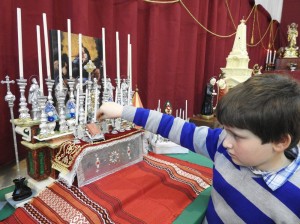 “This year we are delighted to celebrate the 30th anniversary from the establishment of this society,” Pawlu said. “The annual exhibition has been taking place each year. Besides offering the opportunity to showcase our members’ works, this event has served to help our members and the public which visits it, to meditate during the Lent period and to prepare for the Easter celebrations.”
“This year we are delighted to celebrate the 30th anniversary from the establishment of this society,” Pawlu said. “The annual exhibition has been taking place each year. Besides offering the opportunity to showcase our members’ works, this event has served to help our members and the public which visits it, to meditate during the Lent period and to prepare for the Easter celebrations.”A bi-monthly magazine, Il-Knisja Tiegħi (My Church), which was also initiated by Pawlu, is marking its 30th anniversary too. Members have been writing features in it related to different aspects of religious folklore, thereby kindling even further interest in model-making.
Once again this year, the society has organized this exhibition which saw the participation of several of its members. Exhibits varied and included small to large statues of the passion of Christ and Easter, statues of Blessed Mary and several saints, models of altars, church facades and whole churches made of different materials.
 “I hope that I’ll have enough strength to exhibit my large model of St Publius’ church,” revealed Pawlu at one point. “It takes me four weeks to set it up on a large platform and to connect the miniature chandeliers and light fittings to electricity. I am getting old now and such work is very tiring.”
“I hope that I’ll have enough strength to exhibit my large model of St Publius’ church,” revealed Pawlu at one point. “It takes me four weeks to set it up on a large platform and to connect the miniature chandeliers and light fittings to electricity. I am getting old now and such work is very tiring.”Pawlu has been exhibiting this model in a building besides the Floriana Cathecism Museum for many years now, during the feast of St Publius which takes place two weeks after Easter.
“Many people come to visit my model and they are fascinated with it. Tourists take photos besides it and they ask me how I managed to construct it section by section and yet making it look as a whole. I tell them that there are lifetimes of passion invested within it and that it is imbued with a blend of religious meaning and local traditional skills and creativity.”
At 82 years, Pawlu is serene and thankful to see the society which he has founded together with his friends strengthen itself and adding members to it.
“I just wish that it will continue to flourish for very long,” smiled Pawlu as he looked contentedly around him in order to appreciate the beautiful displayed works of the society’s members.
(This article was published in the Easter Supplement which was issued with The Times of Malta dated 21st March 2016)
-
IF THESE WALLS COULD TALK
450 years ago, the Maltese Islands were in the spotlight of several European sovereigns after they had succeeded to come out victorious from the massive siege that was laid upon them by the powerful Ottoman Empire. Fort St Elmo lay in ruins and the other fortifications and houses which had been targeted by the enemy were in no better shape. The land still seeped in the blood of the thousands who had lost their lives during the fighting, whilst many others remained maimed.
Amid this devastation, the eminence of the surviving Knights of the Order of St John surged, and their fame reached legendary proportions. Letters of congratulations which they received from all over Europe, uplifted their spirits, whilst generous donations eventually helped them to build the new city of Valletta.
The Knights of St John continued to rule the Maltese Islands until 1798, when they were ousted by French Military General, Napoleon Bonaparte. Although, some might believe that at this time, the Order was obliterated, in reality, these mythical Hospitallers are still present amongst us, and are as real as ever.
The Russian Grand Priory of Malta
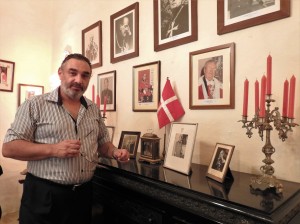 Since the early years of the Hospitallers’ foundation by Blessed Gerard, the Order protected the faithful and provided aid to the sick and poor. These elements have always remained deeply rooted in the mission of the knights who followed throughout the centuries.
Since the early years of the Hospitallers’ foundation by Blessed Gerard, the Order protected the faithful and provided aid to the sick and poor. These elements have always remained deeply rooted in the mission of the knights who followed throughout the centuries.“Even today, as Knights and Dames of the Russian Grand Priory of Malta who form part of the Order of St John of Jerusalem, Knights Hospitallers, under the constitution of the late King Peter II of Yugoslavia, we strive to continue to live up to our motto “Pro Fide, Pro Utilitate Hominum,” declared Chev. Saviour Garcia as we stood in front of a large painting of Blessed Gerard at Palazzino Sapienti in Valletta.
“Today, the Order’s mission still incorporates the duty to profess the Christian faith. However, its present members are not fighters but humanitarians who swear to act for the common good of all people without distinction of race or religion.”
Garcia outlined a number of philantropic projects which the Russian Grand Priory of Malta have been taking care of without much pomposity. Amongst these he mentioned St Joseph’s Residential Home for children in Żabbar, Dar Nazareth’s Residential Home for people with disability in Żejtun, and the construction of a hospital and a hostel in Thailand which caters for the needs of dying children with AIDS.
“The first investiture and the official institution of The Malta Priory took place on March 8, 1964. A few days after, His Majesty King Peter II of Yugoslavia legitimized the Order by giving it a new Constitution to meet 20th century demands. Within the first decades of its existence, The Malta Priory made several notable achievements which ultimately led it to be elevated to Grand Priory by Royal Warrant from King Peter II on Feb 22, 1970. This Royal Warrant gave our Grand Priory the name of Russian Grand Priory of Malta.”
Palazzino Sapienti, Valletta
 Interestingly, it was the same king who donated the sum of 1000 dollars in order to open a fund for the purchase of a large house which was expected to serve as the World Head Quarters of this Order. The choice fell on the prestigious Palazzino Sapienti which today is located at 223, St Paul Street, Valletta, right opposite to the University of Malta Valletta Campus.
Interestingly, it was the same king who donated the sum of 1000 dollars in order to open a fund for the purchase of a large house which was expected to serve as the World Head Quarters of this Order. The choice fell on the prestigious Palazzino Sapienti which today is located at 223, St Paul Street, Valletta, right opposite to the University of Malta Valletta Campus.An original letter held at the archives of Palazzino Sapienti that was sent to Czar Paul I by Grand Master Hompesch in 1797, indicates that at the time, the Russians had an interest to involve themselves in the Order. That is why, after the Knights of St John were expelled from Malta, some of them opted to find refuge in St Petersburg, where they elected the Russian Emperor, Paul I, as their Grand Master, thereby replacing Ferdinand von Hompesch who was then held in disgrace and had to abdicate in 1799.
Prior to its present distinguished function, Palazzino Sapienti had its fair share of interesting history.
“Whilst researching about the origins of this building, I discovered that its construction was commissioned in the late 16th century by the English Grand Prior of the Order of St. John, Sir Richard Shelley. However, he did not have the opportunity to enjoy his residence for long, since he got into disagreement with the Inquisitor after he failed to present to him his correspondence to the Protestant Queen Elizabeth for censorship, as was the regulation at the time. Soon, matters got worse when Shelley had also a dispute with Grand Master Peter del Monte, and in a diplomatic way, this building was taken away from him after he was offered another property. Instead, Palazzino Sapienti became the residence of Fra Nicolo Sollima, the Collegium Melitense Rector,” revealed Garcia.
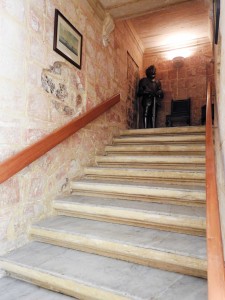 “Stone used for the building of the house was quarried on site. Once the building was complete, the resultant small quarry was used as a water cistern and basement. This process of cutting stones directly from Monte Sciberras hurried the process of the building of the new city.”
“Stone used for the building of the house was quarried on site. Once the building was complete, the resultant small quarry was used as a water cistern and basement. This process of cutting stones directly from Monte Sciberras hurried the process of the building of the new city.”“The facade of the palazzino was imposing, having a main door flanked by two others. The main entrance was decorated by a barrel vaulted ceiling, typical of the 16th century. Traces of a blocked arch located under the staircase which leads up to the piano nobile points out that originally, the level of the street was lower than it is today.”
“On 12th September 1634, a gunpowder magazine located in the whereabouts of the palazzino, blew up, killing 33 persons. The devastated site was left abandoned for thirty years until Grand Master Nicholas Cotoner established the Fondazione Cotoner in order to rebuild the houses in Strada San Paolo. The palazzino had suffered some cracks in the walls and its glass windows were shattered. Some structural changes were done to it, however, this structure was never intended to be built higher than two floors, since it would have been higher than the opposite building and would have cast a shadow on the University’s sundial.”
“Traces of red paint on the walls show that this building was painted in this colour. Meanwhile, the limestone balcony supports, the internal courtyard and the main staircase were adorned with seashell carvings that represented St John the Baptist, the patron saint of the Order of St. John. The seashell is also representative of the water element, in this case creativity and knowledge, as befits the University Rector’s house.”
It was a pleasure to explore this palazzino which I had never visited before. In the meantime, Garcia recounted some curiosities about the notable tenents who lived there.
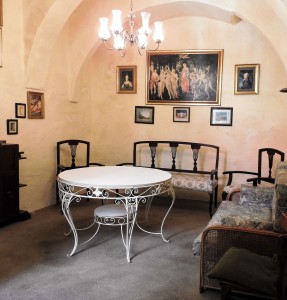 “In 1919, the tenant of Palazzino Sapienti was the lawyer Luigi Camilleri. On 7th June, 1919, Prince Lobanov-Rostovsky and Count Andrey Bobrinsky, both Russian Imperial refugees, were visiting Camilleri at his residence when suddenly the ‘Sette Guigno’ riots broke out. A large crowd made its way to the Royal Malta University and started to attack it, tearing down the English Imperial flag. These two Russian nobles who were witnessing this from the opposite palazzino were scared stiff since the remembrance of the Bolshevik revolution still haunted them. They stayed at the premises till the 12th June when they were escorted back to San Anton Palace in Balzan by Police Superintendent James Frendo Cumbo.”
“In 1919, the tenant of Palazzino Sapienti was the lawyer Luigi Camilleri. On 7th June, 1919, Prince Lobanov-Rostovsky and Count Andrey Bobrinsky, both Russian Imperial refugees, were visiting Camilleri at his residence when suddenly the ‘Sette Guigno’ riots broke out. A large crowd made its way to the Royal Malta University and started to attack it, tearing down the English Imperial flag. These two Russian nobles who were witnessing this from the opposite palazzino were scared stiff since the remembrance of the Bolshevik revolution still haunted them. They stayed at the premises till the 12th June when they were escorted back to San Anton Palace in Balzan by Police Superintendent James Frendo Cumbo.”“During the Second World War, the premises were used by the British Royal Air Force for the decoding of enemy aerial operations. Palazzino Sapienti survived two enemy bombs which were dropped in the vicinity. Yet tragedy still struck this place when two children, who were attending school in this building after the Valletta school was hit, found their way down a spiral staircase which led to the city’s undergrounds and got lost there. No one ever found them and these stairs have been blocked ever since.”
 Today, this building is also proud to possess three saint reliquaries: a first degree bone fragment from the Order’s Patron Saint St. John the Baptist, and two third degree relics in the form of a throne chair on which St. John Paul II sat during one of his Papal visits to Italy, and a hand signed dedication by Sister Mother Theresa of Calcutta who was also a member of the Order.
Today, this building is also proud to possess three saint reliquaries: a first degree bone fragment from the Order’s Patron Saint St. John the Baptist, and two third degree relics in the form of a throne chair on which St. John Paul II sat during one of his Papal visits to Italy, and a hand signed dedication by Sister Mother Theresa of Calcutta who was also a member of the Order.“Besides housing the Seat of the Order of St John of Jerusalem, Knight Hospitaller, Palazzino Sapienti has now opened its doors to the public who might be interested to visit it. Moreover lectures regarding various subjects are organized inside one of its rooms wherein we are also giving the opportunity to university students who would like to present talks about their studies or thesis.”
Certainly, an invitation to such a prestigious, architectural, and historical gem, should not be missed.
(This article was published in ‘Focus Valletta’ Suppliment issued with The Times of Malta dated 30 September 2015)
Travelogue
Archives
| M | T | W | T | F | S | S |
|---|---|---|---|---|---|---|
| « Jan | ||||||
| 1 | 2 | 3 | 4 | 5 | 6 | 7 |
| 8 | 9 | 10 | 11 | 12 | 13 | 14 |
| 15 | 16 | 17 | 18 | 19 | 20 | 21 |
| 22 | 23 | 24 | 25 | 26 | 27 | 28 |
| 29 | 30 | |||||
Recent Posts
- A MATTER OF FATE
- MALTA’S PREHISTORIC TREASURES
- THE MAGIC IS IN THE DETAIL
- THE SELLING GAME
- NEVER FORGOTTEN
- Ġrajjiet mhux mitmuma – 35 sena mit-Traġedja tal-Patrol Boat C23
- AN UNEXPECTED VISIT
- THE SISTERS OF THE CRIB
Comments
- Pauline Harkins on Novella – Li kieku stajt!
- admin on IL-KARNIVAL TRAĠIKU TAL-1823
- Albert on IL-KARNIVAL TRAĠIKU TAL-1823
- Martin Ratcliffe on Love in the time of war
- admin on 24 SENA ILU: IT-TRAĠEDJA TAL-PATROL BOAT C23